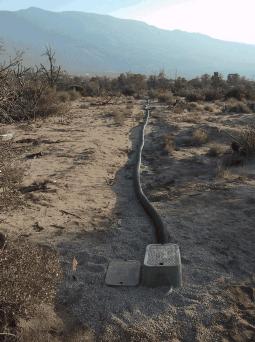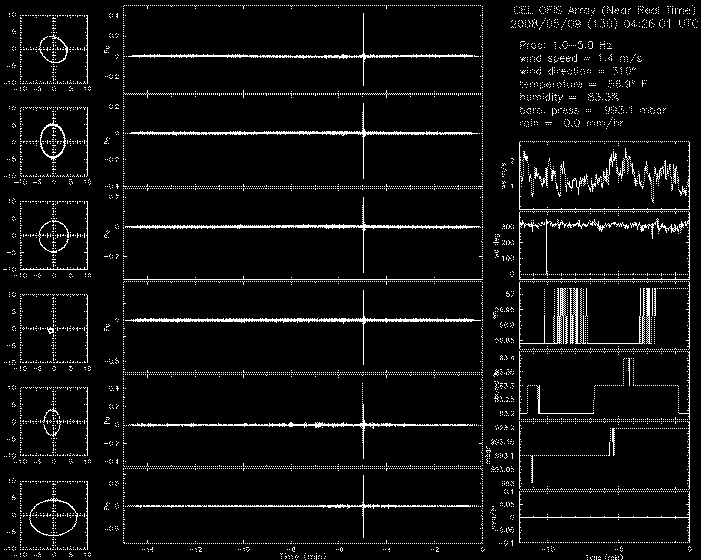|
May 20, 2008
How Does HPWREN Help the Optical Fiber Infrasound Sensor (OFIS)
Development Team?
By Kris Walker, SIO IGPP
Atmospheric infrasound is acoustic energy below the frequency
threshold of human hearing at ~18 Hz. There are a variety of
interesting phenomena that produce infrasound: meteors, aurora,
volcanoes, earthquakes, avalanches, wildfires, storm systems,
tornadoes, ocean waves, and a variety of human activities. The
physics of infrasound propagation is also very interesting due to
the ducting influence of the stratospheric horizontal winds. The
bane of recording atmospheric infrasound is noise generated by wind.
We have been one of the leading institutions in the development of
new infrasound sensors that are designed to be more resilient to
wind noise, which can potentially further all basic research in
infrasound. Traditionally, our outdoor testing facility has been
Piñon Flat Observatory in the Southern California high desert (Fig.
1). During the last two years, we have expanded our testing to a
new facility called Camp Elliott, located in San Diego county (Fig.
1). A near real-time web display is available at
http://sail.ucsd.edu/~ofis/CEL/RT/ (Fig. 2). These sensors are
broadband sensors with flat instrument responses from ~50 s to the
kHz range, and they are sampled at 200 Hz, with about 10-30 channels
at each site. Because they are interferometric sensors, they are
sampled in double precision. At present, there is no commercial
ISP at PFO that offers broadband connectivity, which our research
requires. At Camp Elliott, the cost to IGPP for broadband service
was prohibitive five years ago when it was first connected to HPWREN.
More details on our past research can be found at
http://sail.ucsd.edu/~ofis/sensors.html. In summary, our infrasound
sensor development research at PFO and Camp Elliott would be greatly
disrupted, indefinitely, if HPWREN was dismantled.
|
Fig. 1. Optical Fiber Infrasound Sensors (OFIS) at PFO (left) and
Camp Elliott (right). There are up to six of these experimental
sensors at each site. Each OFIS sensor has a length from 18 to 90
m. Burial in gravel at Camp Elliott provides thermal stability and
additional protection from the wind. Each of these six sensors
yields five 200 Hz channels (~250 kbps total) and therefore requires
a broadband connection to transfer the data to our labs at IGPP.
|
|
Fig. 2. Near-real time display of the performance of the
Optical Fiber Infrasound Sensor array at Camp Elliott (
http://sail.ucsd.edu/~ofis/CEL/RT/). The six OFIS sensors
are separated by several tens of meters to form an array (
http://sail.ucsd.edu/~ofis/CEL/elliott_layout.pdf) that is
capable of determining the direction from which the infrasound
signal originated in the presence of wind. The time window is
15 minutes long. A high amplitude signal can be observed in
the time series at t = -5 min. The ellipses on the left
characterize the quality of the interferometer, which varies
as a function of time. The graphs on the right show the
meteorological data. For example, the average wind at this
time was 1.4 m/s from the west-northwest.
|
HPWREN has benefited tremendously the research presented in the
following papers:
Peer-reviewed:
Zumberge, M.A., J. Berger, M.A.H. Hedlin, E. Husmann, and S. Nooner,
2003, An optical fiber infrasound sensor: A new lower limit on
atmospheric pressure noise between 1 and 10 Hz, J. Acoust. Soc. Am.
113: 2474.
Walker, K.T., Zumberge, M.A., Hedlin, M.A.H., and Shearer, P., 2008,
Methodologies for determining infrasound phase velocity direction
with an array of line sensors, J. Acoust. Soc. Am., [in press].
De-Groot Hedlin, C.D., Hedlin, M.A.H., Walker, K.T., Drob, D.P.,
and Zumberge, M.A., 2008, Study of infrasound propagation from the
Shuttle Atlantis using a large seismic network, J. Acoust. Soc. Am.
[in press].
Proceedings:
Walker, K., Arrowsmith, S., Berger, J., Hedlin, M., and Zumberge,
M., 2004, Resolving infrasound signal back azimuths with arrays of
optical fiber sensors, Proceedings of the 26th Seismic Research
Review, 680-687.
Walker, K.T., Zumberge, M., Berger, J., Hedlin, M., and Arrowsmith,
S., 2005, Detecting and Characterizing Infrasound Signals with
Optical Fiber Infrasound Sensors, Acoustical Society of America
Spring Meeting, Vancouver, Canada. [invited conference paper].
Walker, K.T., Zumberge, M., Berger, J., and Hedlin, M., 2005, An
Improved Method for Determining Infrasound Back Azimuth with Optical
Fiber Sensors, Proceedings of the 27th Seismic Research Review,
855-865.
Walker, K.T., Zumberge, M., Berger, J., and Hedlin, M., 2006,
Determining infrasound phase velocity direction with a three-arm
OFIS, Proceedings of the 28th Seismic Research Review, 947-956.
Walker, K.T., Zumberge, M., Berger, J., Hedlin, M., and Shearer,
P., 2007, An improved method of back azimuth determination with a
multi-arm OFIS, Proceedings of the 29th Monitoring Research Review,
894-904.
Walker, K.T., Zumberge, M., and Dzieciuch, M., 2007, OFIS experiments
at Camp Elliott: Paving the way to infrasonic radar and a portable
infrasonic sensor calibrator, Proceedings of the 29th Monitoring
Research Review, 884-893.
Walker, K.T., Dzieciuch, M., Zumberge, M., and DeWolf, S., 2007,
M-sequences and an array of speakers form a sensor calibrator down
to 8 Hz: application to the ofis at the new Camp Elliott OFIS
array, Infrasound Technology Workshop, Tokyo, Japan, Nov. 13-16,
2007. [abstract].
Walker, K.T., Zumberge, M., Hedlin, M., Berger, J., and Shearer,
P., 2007, Resolving infrasound back azimuth with arrays of optical
fiber infrasound sensors (OFIS): Low wind noise, superb back azimuth
resolution, and a compact design, Infrasound Technology Workshop,
Tokyo, Japan, Nov. 13-16, 2007. [abstract].
Walker, K.T., Zumberge, M., Hedlin, M., Berger, J., and Shearer,
P., 2007, Resolving infrasound signals with arrays of optical fiber
infrasound sensors (OFIS): Wind noise reduction, instrument responses,
and phase velocity direction resolution, Acoustical Society of
America Fall Meeting, New Orleans, Louisiana, Nov. 27-Dec. 1, 2007.
[abstract].
|



